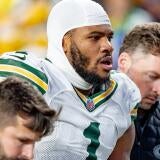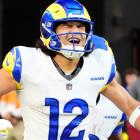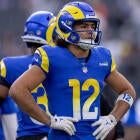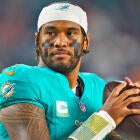Agent's Take: How Chiefs and 49ers have changed financially since meeting in Super Bowl 54
Fittingly, 21 star players are all that remain on the two rosters four years later

The Kansas City Chiefs and San Francisco 49ers are meeting in the Super Bowl for a second time. The first matchup in Super Bowl LIV four years ago was a 31-20 victory for the Chiefs.
A lot has changed for the two participants. Just 10 players who were either on the 53-man roster or reserve list for the first meeting remain on the Chiefs. The only key contributors left on offense or defense are Kansas City's three best players: defensive tackle Chris Jones, tight end Travis Kelce and quarterback Patrick Mahomes.
It's 11 returning players for the 49ers. There's a little more continuity with the 49ers as seven are key contributors from the two sides of the ball. Three come from offense: fullback Kyle Juszczyk, tight end George Kittle and wide receiver Deebo Samuel. The four defensive players are defensive lineman Arik Armstead, edge rusher Nick Bosa, linebacker Dre Greenlaw and linebacker Fred Warner.
The league-wide salary cap was $188.2 million during the 2019 league year. It's currently $224.8 million. Each team's actual salary cap (known as adjusted salary cap) is typically different from the NFL's set amount because unused cap room can be carried over from one year to the next year and other adjustments can further increase or decrease cap space.
A big difference in the adjusted salary cap of the two teams has existed for both matchups. San Francisco has the NFL's third highest adjusted salary cap now. The ranking was the same four years ago. Kansas City is a little better off than in 2019. Instead of having the lowest adjusted salary cap, four teams were behind the Chiefs for the first meeting.
A team has brought up the rear for cap expenditures in each contest. It was the Chiefs in 2019. The 49ers are last now because multiple contracts of players who are among the highest paid at their respective positions (Christian McCaffrey, Kittle, Warner and Trent Williams) were restructured to push 2023 cap obligations into the future.
The contract restructure game wasn't being played to nearly the same extent four years ago. San Francisco had the NFL's most cap expenditures in 2019.
The cap allocation of resources for the key contributors, offense versus defense, with each team has remained relatively constant despite trading places with quarterback spending. Kansas City's key contributor cap spending has been skewed more heavily to the offense while San Francisco's has been slanted toward the defense.
It's less pronounced now with Kansas City than for Super Bowl LIV when twice as much was allocated to offense. The discrepancy in favor of the defense has been close to 20% both times for San Francisco.
Dead money
Dead money exists because of how salary cap accounting rules operate. Signing bonuses, option bonuses and certain roster bonuses are prorated or spread out evenly over the life of a contract for a maximum of five years. When a player is released, traded or retires, the remaining proration of these salary components immediately accelerate onto his team's current salary cap.
There are two major exceptions to this general rule of bonus proration accelerating. Only the current year's proration counts toward the salary cap with transactions occurring after June 1. The bonus proration in future contract years is delayed until the next league year beginning in the following March. A team can also release two players each league year prior to June 2 (known as a post-June 1 designation) that will be treated under the salary cap as if they were released after June 1. With a post-June 1 designation, a team is required to carry the player's full cap number until June 2 even though he is no longer part of the roster. The player's salary comes off the books at that time unless it is guaranteed.
This means dead money is typically a sunk cost where money isn't owed to a player. Only if there are salary guarantees when a player is released will there be a payment associated with dead money.
Offense
Quarterback
The 49ers have gone from a high-priced quarterback to a low-cost passer on a rookie contract. It's the reverse for the Chiefs.
The 49ers took a calculated risk with the five-year, $137.5 million contract given to Jimmy Garoppolo in February 2018. All it took was five impressive starts at the end of 2017 following a midseason trade from the Patriots for Garoppolo to briefly become the NFL's highest-paid player at $27.5 million per year.
The 49ers eventually realized Garoppolo wasn't the answer at quarterback. A move up to the third overall pick was made prior to the 2021 NFL Draft to select Trey Lance to be Garoppolo's successor. Injuries and poor play by Lance in 2022 opened the door for Brock Purdy when he was a rookie. Lance was traded during the preseason to the Dallas Cowboys for a 2024 fourth-round pick. There isn't a better value in the NFL than Purdy since he is in the second year of his rookie contract as "Mr. Irrelevant," the last player selected in the 2022 Draft, with an $897,513 2023 cap number.
Mahomes was a few months away from landing the richest contract in American team sports history with a 10-year, $450 million contract extension, worth up to $475 million through incentives, when Super Bowl LIV was played. Garoppolo's $20 million 2019 cap number was almost four-and-a-half times as much as Mahomes', which was slightly less than $4.5 million. Mahomes has 2023's largest cap number at $37,133,825.
Running back
The Chiefs have had a small financial investment in the running back position each time. The leading rusher in 2019 was journeyman Damien Williams, who was on a two-year, $5.1 million extension worth up to $8.1 million through incentives and salary escalators. Isiah Pacheco, a 2022 seventh-round pick, emerged as Kansas City's primary ball-carrier during the latter part of his rookie year.
The 49ers had a running back-by-committee approach with Matt Breida, Raheem Mostert and Tevin Coleman in 2019. That has changed as McCaffrey, the NFL's highest-paid running back, was acquired from the Carolina Panthers for 2023 second-, third- and fourth-round picks as well as a 2024 fifth-round pick during the 2022 season as the trading deadline was approaching. The four-year extension the Panthers gave McCaffrey in 2020, when he had two years left on his rookie deal, averages $16,015,853 per year.
San Francisco consistently utilizes a fullback more than any other NFL team. Eyebrows were raised in 2017 when Juszczyk was signed to a four-year, $21 million deal that averaged over twice as much as the NFL's second most lucrative fullback contract. Niners general manager John Lynch justified the deal at the signing in describing Juszczyk as a versatile offense weapon. He remains the NFL's highest-paid fullback at $5.4 million per year with the backloaded five-year deal he signed in 2021.
Wide receiver
The Chiefs have taken a different approach to wide receiver. It's a by-product of no longer having Mahomes on a low-cost rookie contract.
Sammy Watkins was being paid like an elite wide receiver without matching production. When Watkins signed with the Chiefs in 2018, his three-year, $48 million deal made him the NFL's fourth-highest-paid wide receiver by average yearly salary. He had the NFL's biggest 2019 wide receiver cap number at $19.2 million. Watkins had his best season with the Chiefs in 2019 by catching 52 passes for 673 yards with three touchdowns.
The Chiefs became the only team with two wideouts on deals averaging at least $16 million per year, when Tyreek Hill signed a team-friendly three-year, $54 million extension right before the 2019 regular season started.
Signability led to Hill's exit from the Chiefs. He was dealt to the Miami Dolphins for five draft picks in March 2022: first-, second- and fourth-round picks in 2022 in addition to 2023 fourth- and sixth-round picks. Hill was given a four-year, $120 million extension, which has $72.2 million in guarantees, by Miami with $52.535 million fully guaranteed at signing.
The Chiefs have tried to replenish the wide receiver corps through the NFL Draft. A second pick was used to take a wide receiver in 2022 (Skyy Moore) and 2023 (Rashee Rice). Rice has emerged as Mahomes' favorite wide receiver target.
Kansas City's major wide receiver acquisition in free agency isn't really panning out. Marquez Valdes-Scantling signed a three-year, $30 million deal, averaging $10 million per year with $15 million of guarantees, in 2022 free agency. Incentives make the maximum value $36 million ($12 million per year). Valdes-Scantling is a potential offseason salary cap casualty after a big decrease in production from last season. He only caught 21 passes for 315 yards with one touchdown in 16 games this season. The Chiefs would pick up $12 million of cap space by letting Valdes-Scantling go.
The 49ers felt a boost was needed at wide receiver to give Samuel, a 2019 second-round pick, more help. Emmanuel Sanders was obtained as a short-term rental from the Denver Broncos along with a 2020 fifth-round pick for 2020 third- and fourth-round picks as the late October trading deadline was approaching. The 49ers assumed the remaining 10 weeks of Sanders' $10.15 million base salary in the trade for a $5,970,588 cap charge.
The 49ers have one of the NFL's best wide receiver tandems and could soon be paying for it like the Chiefs in 2019. Samuel was a part of 2022's wide receiver salary explosion. He signed a three-year, $71.55 million extension, averaging $23.85 million per year with $58.167 million in guarantees, where $41 million was fully guaranteed at signing. Extending 2020 first-round pick Brandon Aiyuk's contract will likely be an offseason priority for the 49ers. He is scheduled to make a fully guaranteed $14.124 million in 2024 on a fifth-year option. Aiyuk could get a deal comparable to Samuel's.
Tight end
Both teams have tight ends near the top of the market. Kittle and Kelce are, respectively, the NFL's third- and fourth-highest-paid tight ends at $15 million and $14,312,500 per year.
That wasn't the case in 2019. The five-year, $45.975 million extension (worth up to $49.975 million through base salary escalators) Kelce received from the Chiefs in 2016 was holding up a stagnant tight end market. Jimmy Graham was the league's only $10 million-per-year tight end.
Kittle was the NFL's biggest bargain at the position. The 2017 fifth-round pick's four-year rookie deal was worth just under $2.7 million. He was one year removed from setting the single-season receiving yard record for a tight end that Kelce subsequently broke in 2020. Kittle dramatically reset the tight end market during training camp following Super Bowl LIV in August 2020. Kelce's current deal came almost immediately after Kittle changed the salary landscape for tight ends.
Offensive line
The 49ers have had one big-ticket item on the offensive line, at left tackle, with both Super Bowl teams. Joe Staley had received a two-year extension, averaging $14 million per year, during the 2019 offseason to become league's sixth-highest-paid offensive lineman.
Williams, who was initially acquired in a 2020 trade with the Washington Commanders, has been the NFL's best left tackle since signing a six-year, $138.06 million contract that made him the league's highest-paid offensive lineman at $23.01 million per year in 2021. He's now third. The 35-year old isn't showing any signs of slowing down.
The Chiefs have had two big offensive line expenditures each time. The Chiefs gave Mitchell Schwartz, arguably the league's best right tackle at the time, a raise although he had two years left on his contract. Schwartz's 2019 compensation almost doubled when increased to $12.53 million in the one-year extension he signed worth $11.255 million. Left tackle Eric Fisher was Kansas City's highest-paid offensive lineman with the four-year, $48.5 million extension, containing $40 million of guarantees, he received in 2016 that made him the league's fourth-highest-paid offensive lineman when signed.
Joe Thuney, who is expected to miss the Super Bowl with a pectoral injury, became the NFL's highest-paid offensive guard when the Chiefs signed him to a five-year, $80 million contract containing $46.89 million of guarantees in 2021 free agency. The Chiefs surprisingly put Jawaan Taylor in the exclusive $20 million-per-year offensive lineman club, which has eight members, rather than re-sign left tackle Orlando Brown Jr., who played 2022 under a $16.662 million franchise tag. Taylor signed a four-year, $80 million contract with $60 million in guarantees, of which $40 million was fully guaranteed at signing. He was expected to make the transition to left tackle until Buccaneers castoff Donovan Smith was signed to a one-year, $3 million deal worth up to $9 million through incentives.
Defense
Edge rusher
Each team made a trade for a pass rusher given a franchise tag in 2019. The 49ers dealt a 2020 second-round pick to the Chiefs for Dee Ford, who signed a team-friendly five-year, $85 million contract in conjunction with the trade. Persistent back problems plagued Ford during his three-year stint with the 49ers. Because Ford was released in July 2022, the 49ers have an $8,589,999 2023 cap charge for him.
The Chiefs gave Frank Clark a five-year, $104 million contract with $62.305 million in guarantees ($43.805 million fully guaranteed at signing) when he was acquired from the Seahawks for a 2019 first-round pick and a 2020 second-rounder shortly before the 2019 Draft was held. There was also a swap of 2019 third-round picks. Clark took a substantial pay cut to remain with the Chiefs in 2022. He was released in March.
The 49ers further bolstered their pass rush by taking Nick Bosa with the second overall pick in the 2019 Draft. Bosa became the NFL's highest-paid non-quarterback with a five-year, $170 million extension, averaging $34 million per year, a couple days before the regular season opener to end his holdout. The deal has non-quarterback records of $122.5 million in overall guarantees and $88 million fully guaranteed at signing.
The release of Clark meant the end of Kansas City's major edge rusher investment. Kansas City's most productive edge rusher is 2022 first-round pick George Karlaftis, whose 10.5 sacks tied for the team lead.
Defensive interior
Neither team had substantial resources devoted to the interior of their defensive lines for Super Bowl LIV. The best players were on rookie contracts. That has changed.
A franchise tag was soon to come for Chris Jones. He signed a four-year, $80 million deal (worth up to $85 million through incentives) with $60 million of guarantees in 2020 as a franchise player.
Jones' days in Kansas City could be numbered. The Chiefs planned on extending Jones' contract after beating the Philadelphia Eagles in Super Bowl LVII last February. Jones and the Chiefs weren't in the same ballpark on a contract extension although both sides felt he should be the NFL's second-highest-paid interior defensive lineman. His 51-day holdout came to an end without a long-term deal before preparations for Kansas City's second regular-season game began.
Instead, modifications were made to Jones' remaining 2023 contract year. Jones' $1.25 million sack incentive was made a part of the $5.5 million of new performance bonuses that were added as an option bonus escalator to pick up a voiding 2028 contract year. There's a provision designed to force the Chiefs to exercise the option. Voiding 2024 through 2027 contract years were also included. It was done this way because the $6.75 million would have classified as likely to be earned incentives. Jones earned $4.25 million of the escalator.
Using a 2024 franchise tag on Jones will be an expensive proposition. Jones' franchise tag projects to $32,169,912 because of how the 120% of prior year's salary provisions work with the designation. This would easily be the largest franchise tag for a non-quarterback in league history.
The 49ers were on the cusp of facing an either-or proposition for a long-term deal with Arik Armstead and DeForest Buckner. Armstead had a long-awaited breakout season in 2019 with 10 sacks while playing under a $9.046 million fifth-year option. Buckner, who was scheduled to play 2020 on a $12.378 million fifth-year option, was dealt to the Colts for the 13th overall pick in the 2020 Draft. He was given a four-year, $84 million extension, averaging $21 million per year, with $56.378 million of guarantees in connection with the trade. The deal made Bucker the NFL's second-highest-paid interior defensive lineman.
Armstead signed a five-year, $85 million deal, averaging $17 million per year, to remain in San Francisco. The draft capital essentially obtained for Buckner was used on his replacement. Javon Kinlaw was taken with 2020's 14th overall pick after moving down one spot in a trade with the Tampa Bay Buccaneers. He has been a disappointment.
Kinlaw's inability to be a suitable replacement for Buckner led to the 49ers making a splash in 2022 free agency. Javon Hargrave was signed to a four-year, $84 million contract, averaging $21 million per year, despite being 30 years old.
Linebacker
The 49ers have been more willing to make a significant financial investment in off-ball linebackers than most other teams. A stagnant inside linebacker market was jump-started when the 49ers briefly made Kwon Alexander, who tore the ACL in his left knee during the middle of 2018 season, the highest-paid player at the position on a four-year deal, averaging $13.5 million per year, in 2019. While Alexander missed 2019's last eight regular-season games with a torn pectoral muscle, it became clear that 2018 third-round pick Fred Warner was San Francisco's best linebacker.
Warner and 2019 fifth-round pick Dre Greenlaw soon made Alexander expendable. Alexander was dealt to the Saints in 2020 at the midseason trading deadline. Warner was the first off-ball linebacker to hit the $19 million-per-year mark with the five-year extension, averaging $19.045 million, he received from the 49ers just before the start of training camp in 2021. Greenlaw is underpaid at $8.2 million per year. He forms one of the league's best off-ball linebacker combinations with Warner.
The Chiefs have gotten away from putting money into linebacker since releasing Anthony Hitchens in 2022. Hitchens had been playing under the five-year, $45 million deal with $25 million of guarantees worth as much as $49.25 million through incentives he signed as a free agent in 2018.
Kansas City's best linebackers are on rookie contracts. Nick Bolton and Willie Gay Jr., respectively, are 2021 and 2020 second-round picks.
Cornerback
San Francisco has been willing to spend at cornerback, but only for one player. It was Richard Sherman in 2019. Sherman was in the second year of a three-year, $27.15 million contract worth up to $39.15 million through not so easily achievable incentives.
Now, it's Charvarius Ward. He signed a three-year, $40.5 million contract (worth up to $42 million through incentives) with $26.62 million of guarantees in 2022 to join the 49ers.
Cornerback hasn't been a priority financially for the Chiefs. There has been a heavy reliance on players with rookie contracts. Kendall Fuller and Ward went to the Commanders and 49ers as free agents in 2020 and 2022. Kansas City's top four cornerbacks (Trent McDuffie, L'Jarius Sneed, Jaylen Watson and Joshua Williams) are on rookie contracts.
Chiefs general manager Brett Veach has indicated he would like to retain Sneed, who is an impending free agent. That's probably going to mean paying Sneed more than Ward got on the open market two years ago.
Safety
The Chiefs are taking a different approach at safety than with cornerbacks. Tyrann Mathieu was given a three-year, $42 million contract, which put him at the top of the safety market, to help transform a Kansas City defense that was a weakness in 2018. Justin Reid was signed to a three-year, $31.5 million deal with $20.485 million fully guaranteed as an unrestricted free agent in 2022 to essentially replace Mathieu, whose contract expired after the 2021 season.
The 49ers are getting to be like the Chiefs with linebackers. Free safety Jimmie Ward was rewarded in 2020 with a three-year, $28.5 million deal. He had returned to the 49ers in 2019 on a one-year, $4.5 million deal worth up to $5 million with incentives after his rookie contract expired. Ward left for the Houston Texans last offseason in free agency.
San Francisco's best safety, Talanoa Hufanga, is on his rookie contract. The 2021 fifth-round pick was a first-team All-Pro last season. He was lost to a torn right ACL in a Week 11 game against the Buccaneers.
Special teams
The 49ers are willing to use draft capital for the kicking game. Mitch Wishnowsky was the first of two punters taken in the 2019 Draft. He was a fourth-round pick. He signed a four-year extension, averaging $2.8 million per year, in 2022.
The 49ers used a late third-round pick to select Jake Moody in the 2023 NFL Draft to replace 18-year veteran Robbie Gould, whose $3.625 million-per-year contract had expired. Moody was the first of three kickers taken.
The Chiefs were smart to be proactive in signing kicker Harrison Butker to a long-term deal in the 2019 offseason, averaging $4.055 million per year, even though he was an exclusive rights player scheduled to make $645,000 in 2019. He's entering his contract year in 2024.
Tommy Townsend, who earned Pro Bowl and first-team All-Pro honors in 2022, played this season under a $2.627 million restricted free agent tender. His signing as an undrafted free agent in 2020 coincided with longtime Chiefs punter Dustin Colquitt's release from his three-year contract, averaging $2.5 million per year.

















